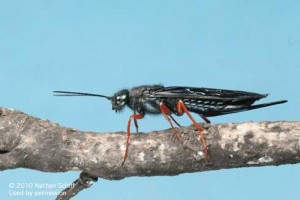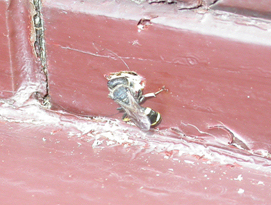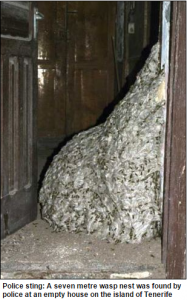The names “wood wasp” is a wood-boring insect in the order Hymenoptera, family Siricidae. Of greatest concern are the large, non-stinging wasps that normally are attracted to and complete their life cycles in newly dead or dying conifer trees. Timber salvaged from these trees can be processed into infested lumber. This can lead to adult wasps emerging in recently completed buildings or structures.
family Siricidae. Of greatest concern are the large, non-stinging wasps that normally are attracted to and complete their life cycles in newly dead or dying conifer trees. Timber salvaged from these trees can be processed into infested lumber. This can lead to adult wasps emerging in recently completed buildings or structures.
The dozen species of wood wasps in California, Oregon, and Washington look similar. They are large insects, generally 1 inch or longer, and wasplike in appearance but have an elongated, cylindrical body without a noticeable constriction or “waist.” They often are black or metallic dark blue or combinations of black, red, and yellow. They make a noisy buzz when flying. A female wood wasp drills her ovipositor nearly 3/4 inch into the wood of a weakened or dying tree and lays 1 to  7 eggs. At the same time, she squirts in a fungus from her abdominal gland. She continues this process, laying up to 200 eggs.
7 eggs. At the same time, she squirts in a fungus from her abdominal gland. She continues this process, laying up to 200 eggs.
The eggs hatch in around 4 weeks and the larva spends its time eating the wood-destroying fungi that its mother thoughtfully injected along with the egg. At the base of the ovipositor there is a pair of glands that contain the fruiting bodies of the fungus, and some of these are injected with each egg.
Wood wasp damage in buildings is more cosmetic than structurally weakening. The total number of insects emerging in any one house is limit ed, usually fewer than a dozen. Emerging wood wasps can chew throughjust about any substance, and you can see their large exit holes in wallboard or plaster walls, hardwood floors, linoleum, carpeting, nonceramic floor tiles, and other interior surfaces.
ed, usually fewer than a dozen. Emerging wood wasps can chew throughjust about any substance, and you can see their large exit holes in wallboard or plaster walls, hardwood floors, linoleum, carpeting, nonceramic floor tiles, and other interior surfaces.
Wood wasps don’t reinfest structures. Even if male and female wood wasps had the opportunity to mate in the building, the females would not be stimulated to lay eggs in dry, finished lumber.
Though they are not as aggressive as carpenter ants or drywood termites, their presence is not welcomed equally. Let’s take a look at the following news article on wood wasp;
That’s what you call a sting operation: Police seal off house on holiday Island after seven meter wasps nest found
By STEVE NOLAN, 12 April 2013
A seven metre long wasps nest has reportedly been discovered in an abandoned house by police officers in Spain.
Officers were called to the empty property in San Sebastian de La Gomera on the island of Tenerife after a series of calls from concerned neighbors. Police sealed off the home when the found the 22ft nest, which is said to have almost filled a room, and millions of wasps in the house, according to UPI.com.
Experts believe that the nest was built by an African species of wasp which had migrated to Tenerife.
The Canary Islands are located around 100km from the African coast.
Police are said to be trying to find out who the property belongs to.
The nest may well be the biggest ever found.
According to the Guinness Book of World Records, the largest one found to date  was discovered in Waimaukau in New Zealand in April 1963 and was an impressive 3.7metres, or 12ft 2ins long, more than 5ft in diameter and 18ft in circumference.
was discovered in Waimaukau in New Zealand in April 1963 and was an impressive 3.7metres, or 12ft 2ins long, more than 5ft in diameter and 18ft in circumference.
Thought to have been created by German wasps, that nest was so heavy that it fell from the tree it was hanging in and broke in two.
The size, type, and color of a wasps nest depends on the species of wasp that builds it.
They tend to be predominantly made from paper pulp – the wasp gathers wood fibers from weathered wood and softens it by chewing and mixing with saliva.
The previous biggest nest in the last 50 years was discovered in the attic of a pub in Southampton, Hampshire, in 2010.
Measuring 6ft by 5ft the nest was home to an estimated 500,000 wasps.
Another giant nest was found at the Avery Garden Centre in Taunton, Somerset last summer.
The average common wasp nest contains around 4,000 to 5,000 wasps – but colonies have been known to reach populations of 20,000.
Though the wood wasps are mild in comparison to termites and carpenter ants, no one wants to want to discover a big foul wood wasp nest in our house.
To curb this problem of the wood wasp, a unique solution in contrast to the typical hazardous, non-effective has to be adopted. And there is a solution, infact a Green solution provided by C Tech Corporation: TERMIREPEL™. Termirepel™ is a non-toxic, non-hazardous and environmentally friendly product, with a high efficacy to repel insects like wood borers from the wood. Termirepel™ is a multitasking product; along with wood wasp, it protects the wood from vicious termites, notorious carpenter ants, and other insects. Termirepel™ in solution form can be injected at the high pressure in the lumber so as to prevent the infestation. It is also available in lacquer form which can be applied on the furniture, patios, floor as the coating so as to prevent further infestation.
Hence to help alleviate or else completely eradicate the infestation we C Tech Corporation provide you with the best effective solutionCombirepel™. Combirepel™ is an anti-insect aversive developed on the grounds of green chemistry and technology.
Our product works on the mechanism of repellency. It temporarily inhibits the mating cycle of the insects. The product impairs the ability of the insects to reproduce, that is the insects will not lay eggs or the laid eggs will be infertile. The product causes feeding disruption in an insect by triggering an unpleasant reaction within the insect which might try to feed on the application. The product temporarily blocks the reproduction system of the insects by hindering the release of the vital hormones for growth.
Combirepel™ is thermally stable and does not degrade on exposure to heat and sunlight. It does not kill or harm the insect but repels them. It does not volatilize and does not degrade the soil. It is RoHS, RoHS2, ISO, REACH, APVMA, NEA compliant and FIFRA exempted.
Combirepel™ is an eco-friendly product which acts as an aversive to repel the pesky insects like roaches. Combirepel™ do not kill the targeted as well as non-targeted species but just repel them causing no harm any to human and environment.
Combirepel™is available in the form of the masterbatch, liquid concentrate, and lacquer. Our Combirepel™ masterbatch can be used in polymer base applications like wires, cables, irrigation pipes, polymeric vessels, and other various applications.
Combirepel™ liquid concentrate can be mixed in the paints to cover the areas like cracks and crevices of walls and hidden places where the roaches tend to survive.
Combirepel™ lacquer is the topical coating to cover the places like bathrooms, cupboards, steam tunnels, etc.
Hence we provide you with the best effective solution.
Contact us as technical.marketing@ctechcorporation.com to get solution on pest nuisance.
Also, visit our websites:
http://www.ctechcorporation.com/
http://www.rodrepel.com/
http://www.termirepel.com/
http://www.combirepel.com/
Follow our Facebook pages at:
1] https://www.facebook.com/Combirepel-411710912249274/
2] https://www.facebook.com/Termirepel-104225413091251/
3] https://www.facebook.com/Rodrepel-120734974768048/
Follow us on our Twitter pages at:
1] https://twitter.com/rodrepel
2] https://twitter.com/termirepel
3] https://twitter.com/combirepel

